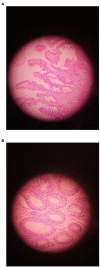Enterotoxigenic Bacteroides fragilis: A Possible Etiological Candidate for Bacterially-Induced Colorectal Precancerous and Cancerous Lesions
- PMID: 32010637
- PMCID: PMC6978650
- DOI: 10.3389/fcimb.2019.00449
Enterotoxigenic Bacteroides fragilis: A Possible Etiological Candidate for Bacterially-Induced Colorectal Precancerous and Cancerous Lesions
Abstract
Enterotoxigenic Bacteroides fragilis (ETBF) produces Bacteroides fragilis toxin (BFT), which is associated with acute diarrheal, inflammatory bowel disease, and colorectal cancer (CRC). In experimental models, ETBF has been shown to contribute to colon carcinogenesis. The present study was conducted to investigate mucosal colonization of ETBF in the colon to find a possible association between the presence of ETBF and precancerous and cancerous lesions. The mucosal biopsies of involved sites were obtained from 68 patients with precancerous and cancerous lesions and 52 healthy controls (HC). The samples were cultured on Bacteroides Bile Esculin agar. Then, specific primers were designed to detect B. fragilis and bft gene using quantitative real-time PCR, and the possible links of ETBF with clinicopathological characteristics was evaluated. Also real-time PCR was performed to detect the bft gene subtypes. Bacteroides fragilis was detected in 51% of the patients and 48% of HCs cultures. The 16SrRNA gene was found to be present in 63 and 81% of the patients and HCs' samples, respectively. Moreover, the bft gene was detected in 47 and 3.8% of the patients and HCs, respectively. Also, B. fragilis was significantly more abundant in the patients' samples compared to those of HCs. In the patient group, higher odds ratio (OR) of ETBF was significantly associated with serrated lesions and adenoma with low-grade dysplasia. The bft1 gene was the most prevalent subtype of bft gene, followed by the bft2 gene. This was the first study in Iran to demonstrate increased positivity of ETBF in patients with precancerous and cancerous lesions. In this study, the bft gene was found to be associated with CRC, especially in the patients with precancerous lesions and initial carcinogenic lesions. Moreover, the results suggest that mucosal BFT exposure is common and could be a risk factor and a screening marker for developing CRC.
Keywords: adenoma; bft gene; colorectal cancer; enterotoxigenic Bacteroides fragilis (ETBF); precancerous lesions.
Copyright © 2020 Zamani, Taslimi, Sarabi, Jasemi, Sechi and Feizabadi.
Figures
Similar articles
-
A systemic review of the role of enterotoxic Bacteroides fragilis in colorectal cancer.Neoplasia. 2022 Jul;29:100797. doi: 10.1016/j.neo.2022.100797. Epub 2022 Apr 20. Neoplasia. 2022. PMID: 35461079 Free PMC article.
-
The Bacteroides fragilis toxin gene is prevalent in the colon mucosa of colorectal cancer patients.Clin Infect Dis. 2015 Jan 15;60(2):208-15. doi: 10.1093/cid/ciu787. Epub 2014 Oct 9. Clin Infect Dis. 2015. PMID: 25305284 Free PMC article.
-
Screening for enterotoxigenic Bacteroides fragilis in stool samples.Anaerobe. 2016 Aug;40:50-3. doi: 10.1016/j.anaerobe.2016.05.004. Epub 2016 May 7. Anaerobe. 2016. PMID: 27166180
-
The association between fecal enterotoxigenic B. fragilis with colorectal cancer.BMC Cancer. 2019 Sep 5;19(1):879. doi: 10.1186/s12885-019-6115-1. BMC Cancer. 2019. PMID: 31488085 Free PMC article.
-
Enterotoxigenic Bacteroides fragilis: a rogue among symbiotes.Clin Microbiol Rev. 2009 Apr;22(2):349-69, Table of Contents. doi: 10.1128/CMR.00053-08. Clin Microbiol Rev. 2009. PMID: 19366918 Free PMC article. Review.
Cited by
-
Gut microbiota, inflammatory bowel disease and colorectal cancer.World J Gastroenterol. 2022 Aug 14;28(30):4053-4060. doi: 10.3748/wjg.v28.i30.4053. World J Gastroenterol. 2022. PMID: 36157114 Free PMC article. Review.
-
Keystone pathobionts associated with colorectal cancer promote oncogenic reprograming.PLoS One. 2024 Feb 16;19(2):e0297897. doi: 10.1371/journal.pone.0297897. eCollection 2024. PLoS One. 2024. PMID: 38363784 Free PMC article.
-
Gut microbiota modulation: a tool for the management of colorectal cancer.J Transl Med. 2022 Apr 21;20(1):178. doi: 10.1186/s12967-022-03378-8. J Transl Med. 2022. PMID: 35449107 Free PMC article. Review.
-
A systemic review of the role of enterotoxic Bacteroides fragilis in colorectal cancer.Neoplasia. 2022 Jul;29:100797. doi: 10.1016/j.neo.2022.100797. Epub 2022 Apr 20. Neoplasia. 2022. PMID: 35461079 Free PMC article.
-
The role of microbiota in colorectal cancer.Folia Microbiol (Praha). 2022 Oct;67(5):683-691. doi: 10.1007/s12223-022-00978-1. Epub 2022 May 10. Folia Microbiol (Praha). 2022. PMID: 35534716 Review.
References
Publication types
MeSH terms
Substances
LinkOut - more resources
Full Text Sources
Medical


